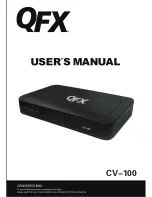
IM 12D7B4-E-H
33
8. MAINTENANCE
8-1. Periodic Maintenance
Display
The front of the unit is sealed to IP65
(NEMA 4X). In normal operation EXAxt will
be sealed to the flat panel front, with a built
in gasket. Behind the panel, the unit has an
IP20 rating.
The converter requires very little periodic
maintenance, except to make sure the front
window is kept clean in order to permit a
clear view of the display and allow proper
operation of the touchscreen. If the window
becomes soiled, clean it using a soft damp
cloth or soft tissue. To deal with more
stubborn stains, a neutral detergent may
be used.
NOTES:
Never use harsh chemicals or solvents. In
the event that the window does become
heavily stained or scratched, refer to the
parts list (Chapter 9) for replacement part
numbers.
The nature of the EXAxt SC150 is that the
panel environment should protect the back
of the instrument. Exposure of this part of
the unit to moisture may result in problems.
This is especially true because of the high
impedance sensors that the pH
measurement uses. This should be borne
in mind when working behind the panel.
Battery
The EXAxt analyzer contains a logbook
feature that uses a clock to provide the
timings. The instrument contains a lithium
cell (battery) to support the clock function
when the power is switched off. The cell
has an expected working life of 10 years.
Should this cell need to be replaced,
contact your nearest Yokogawa service
center for spare parts and instructions.
Fuse
There is a circuit board mounted fuse
protecting the instrument. If you suspect
that this needs to be replaced, contact
your nearest Yokogawa service center for
spare parts and instructions
8-2. Periodic Maintenance of the Sensor
NOTE:
Maintenance advice listed here is
intentionally general in nature. Sensor
maintenance is highly application specific.
In general conductivity/resistivity
measurements do not need much periodic
maintenance. If the EXAxt indicates
an error in the measurement or in the
calibration, some action may be needed
(ref. chapter 9 troubleshooting).
When a 2-electrode sensor has become
fouled an insulating layer may be formed
on the surface of the electrodes and
consequently, an apparent increase in cell
constant may occur, giving a measuring
error.
This error is:
2 x Rv/Rcel x 100 %
where:
Rv = the resistance of the fouling layer
Rcel = the cell resistance
NOTE:
Resistance due to fouling or to polarization
does not effect the accuracy and operation
of a 4-electrode conductivity measuring
system. If an apparent increase in cell
constant occurs cleaning the cell will
restore accurate measurement.
8-3. Cleaning Methods
1.
For normal applications hot water with
domestic washing-up liquid added will be
effective.
2.
For lime, hydroxides, etc., a 5 ...10%
solution of hydrochloric acid is
recommended.
3.
Organic contaminants (oils, fats, etc.)
can be easily removed with acetone.
4.
For algae, bacteria or moulds, use a
solution of domestic bleach (hypochlorite).
*
Never use hydrochloric acid and bleaching
liquid simultaneously. The release of the
very poisonous chlorine gas will result.
Summary of Contents for SC150
Page 2: ......
Page 20: ...IM 12D7B4 E H 14...
Page 21: ...IM 12D7B4 E H 15 5 MENU STRUCTURE COMMISSIONING...
Page 35: ...IM 12D7B4 E H 29 Time Span x 1 hour Temperature Concentration...
Page 49: ...IM 12D7B4 E H 43...
Page 50: ...IM 12D7B4 E H 44...
Page 56: ...QIS 12D7B4 E H 50...
















































